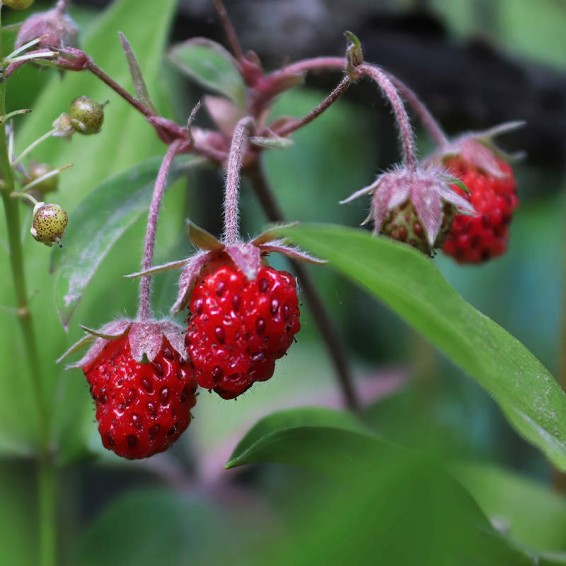Wild Strawberry Seeds
- HOW TO GROW
- FAST FACTS
- REVIEWS
HOW TO GROW
Sowing: To break the wild strawberry seed's dormancy, store it in damp media in the fridge for 4-6 weeks before planting. Plant the seeds 1/4" below the surface in a flat; keep the soil fairly warm and in filtered or indirect sunlight until germination, which should take from 3-4 weeks. The germination rate may be naturally low, and the seedlings will grow rather slowly at first. Transplant seedlings to individual peat pots, and plant them outdoors as soon as they have become well established.
Growing: Keep the plants evenly moist, especially when they are blooming and setting fruit. This plant prefers rich soil with consistent moisture, and adapts well to woodland soil. A layer of pine needles or leaf mulch will help conserve moisture and control weeds. The Fragaria virginiana plant spreads by rhizomes, seeds, and runners and will quickly form a native ground cover; keep the runners pruned for healthy and compact growth. After several years of growth, the plants can be divided in the fall for new plants and increased production. This plant is not prone to foliar pests, though wildlife of all kinds will eat the fruit; the plant also attracts butterflies and bees.
Harvesting: Wild Strawberries are deliciously sweet when eaten raw or preserved. Pick the berries as soon as they ripen, since birds and small animals love to eat them. The dried leaves of these plants make an excellent, vitamin rich tea when brewed.
Seed Saving: Pick the ripe strawberries and crush them, then add a cup of water. The strawberries and water can also be placed in the blender and processed for 5-10 seconds; since the Fragaria virginiana seeds are hard and slippery, they will not be damaged. Pour the mixture into a bowl and let it settle. Discard the seeds and pulp floating on top, and save the good seeds that have sunk to the bottom of the bowl. Rinse them clean, then spread them out to dry completely. Store them in a sealed container in the refrigerator until planting.
FAST FACTS
Common Names: Virginia Strawberry, Thickleaved Wild Strawberry
Latin Name: Fragaria virginiana
Species Origin: US Native Wildflower
Type: Native Wildflowers
Life Cycle: Perennial
USDA Zones: 2, 3, 4, 5, 6, 7, 8, 9
US Regions: California, Mountain, Arid/Desert, Plains/Texas, Midwest, Northern, Northeast, Southeast
Seeds per Ounce: 71,500
Stratification: Cold/Wet for 8 Weeks
Germination Ease: Stratify 8 Weeks
Sunlight: Full Sun, Part Sun, Shade
Height: 6 Inches
Color: White
Bloom Season: Blooms Early Spring, Blooms Late Spring
Uses: Attracts Pollinators, Attracts Butterflies
Nothing better
No issue arrived on time and in good condition with planting instructions
DESCRIPTION
HOW TO GROW
Sowing: To break the wild strawberry seed's dormancy, store it in damp media in the fridge for 4-6 weeks before planting. Plant the seeds 1/4" below the surface in a flat; keep the soil fairly warm and in filtered or indirect sunlight until germination, which should take from 3-4 weeks. The germination rate may be naturally low, and the seedlings will grow rather slowly at first. Transplant seedlings to individual peat pots, and plant them outdoors as soon as they have become well established.
Growing: Keep the plants evenly moist, especially when they are blooming and setting fruit. This plant prefers rich soil with consistent moisture, and adapts well to woodland soil. A layer of pine needles or leaf mulch will help conserve moisture and control weeds. The Fragaria virginiana plant spreads by rhizomes, seeds, and runners and will quickly form a native ground cover; keep the runners pruned for healthy and compact growth. After several years of growth, the plants can be divided in the fall for new plants and increased production. This plant is not prone to foliar pests, though wildlife of all kinds will eat the fruit; the plant also attracts butterflies and bees.
Harvesting: Wild Strawberries are deliciously sweet when eaten raw or preserved. Pick the berries as soon as they ripen, since birds and small animals love to eat them. The dried leaves of these plants make an excellent, vitamin rich tea when brewed.
Seed Saving: Pick the ripe strawberries and crush them, then add a cup of water. The strawberries and water can also be placed in the blender and processed for 5-10 seconds; since the Fragaria virginiana seeds are hard and slippery, they will not be damaged. Pour the mixture into a bowl and let it settle. Discard the seeds and pulp floating on top, and save the good seeds that have sunk to the bottom of the bowl. Rinse them clean, then spread them out to dry completely. Store them in a sealed container in the refrigerator until planting.
FAST FACTS
Common Names: Virginia Strawberry, Thickleaved Wild Strawberry
Latin Name: Fragaria virginiana
Species Origin: US Native Wildflower
Type: Native Wildflowers
Life Cycle: Perennial
USDA Zones: 2, 3, 4, 5, 6, 7, 8, 9
US Regions: California, Mountain, Arid/Desert, Plains/Texas, Midwest, Northern, Northeast, Southeast
Seeds per Ounce: 71,500
Stratification: Cold/Wet for 8 Weeks
Germination Ease: Stratify 8 Weeks
Sunlight: Full Sun, Part Sun, Shade
Height: 6 Inches
Color: White
Bloom Season: Blooms Early Spring, Blooms Late Spring
Uses: Attracts Pollinators, Attracts Butterflies
Reviews
Review
Nothing better
No issue arrived on time and in good condition with planting instructions





